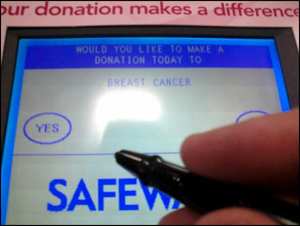I get phone calls all the time from various cancer nonprofit organizations, and I want to trust they are carrying out whatever mission they say they will. But I found out that isn’t always the case. Take cancer-research nonprofit organizations for instance: Much of the money I thought went to research goes to fundraising instead. I consider bad distribution of funds to be as bad as out-and-out fraud where charity officials simply take the money as salary.
Cancer Research
I read that breast-cancer research organizations have become a “gold mine for pink profiteers and old-fashioned hucksters” in Marie Claire. Cancer-research organizations, in general, have earned a bad reputation for walking the fraud line. Time magazine reported on an organization, the National Breast Cancer Research Center, which raised more than $12 million in 2009. It spent 52 percent of that money on fundraising; only 4 percent of the money raised went to research. Another charity, the National Charity for Cancer Research, used none of the $5.3 million it raised on research.
Donating to Mismanaged Charities
The rule of thumb I now go by is one I learned from Greg Simon, former head of FasterCures, a nonprofit that focuses on improving medical research: Namely that if I donate to a charity that spends little to no money on its intended goal, I’ve thrown away my money. Plus, people are dying of cancer when badly managed charities are collecting money that could be put to better use, such as care or actual research. Many charities become more focused on the fundraising aspect or attracting prominent people to serve on their boards than on what the charity was set up for in the first place.
Some Examples
The more common the cancer, the bigger the problem with mismanaged funds. Pediatric cancer, I learned, has its share of failed charities. The Children’s Cancer Research Fund sends a nickel along with its pleas for help. In 2009, this charity spent almost $10 million on direct mail and other expenses and gave only $2.7 million to research. A group called Charity Navigator, which grades charities, gave CCRF a zero rating. Back in 2001, an organization called the Coalition Against Breast Cancer was found to have spent all the money it raised on staff salaries. One woman who was solicited to donate and refused was sent an invoice anyway. In 2010, New York Attorney General Eric Schneiderman filed a lawsuit, calling the Coalition Against Breast Cancer a “sham charity.” It operated deceptively for 15 years.
Check Out Charities
Before I give to a charity, I now check its financial reports before donating. I can typically find this information on the charity’s website. If no financial information is listed, I might call. But, if I still don’t get a suitable answer, I’ll look for a different charity. Charities need to file financial reports with the Internal Revenue Service, so if they are reluctant to make the reports public, my fraud radar goes off. Sometimes, charities don’t even try to hide their financial reports, though they indicate the charity doesn’t live up to its mission. The Better Business Bureau reported that the Breast Cancer Society gives less than a penny for every dollar it receives for cancer patients. Most of the money a charity receives, about 60 percent to 75 percent, should be spent toward an organization’s mission. As Daniel Borochoff, president of the American Institute of Philanthropy, a Chicago nonprofit watchdog group, said, “Any bozo can set up [a charity] and start soliciting.”
